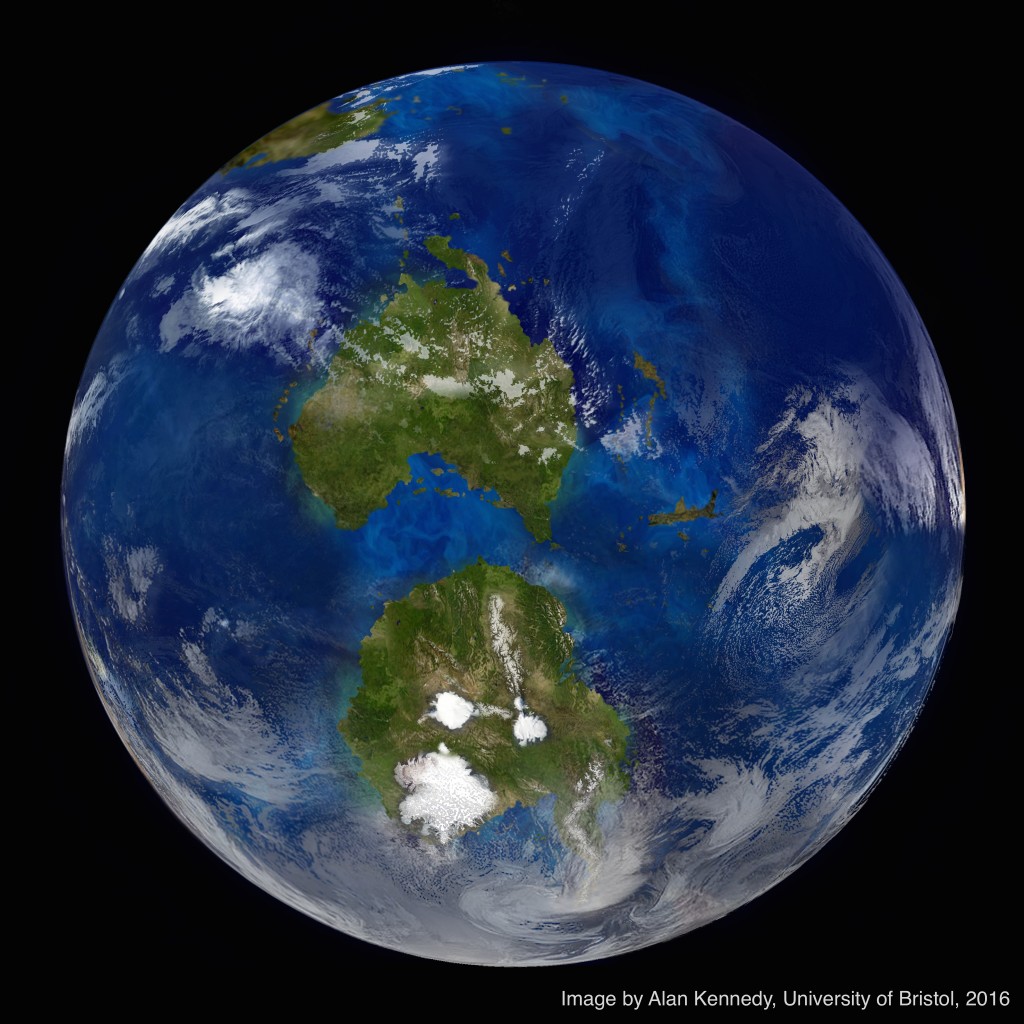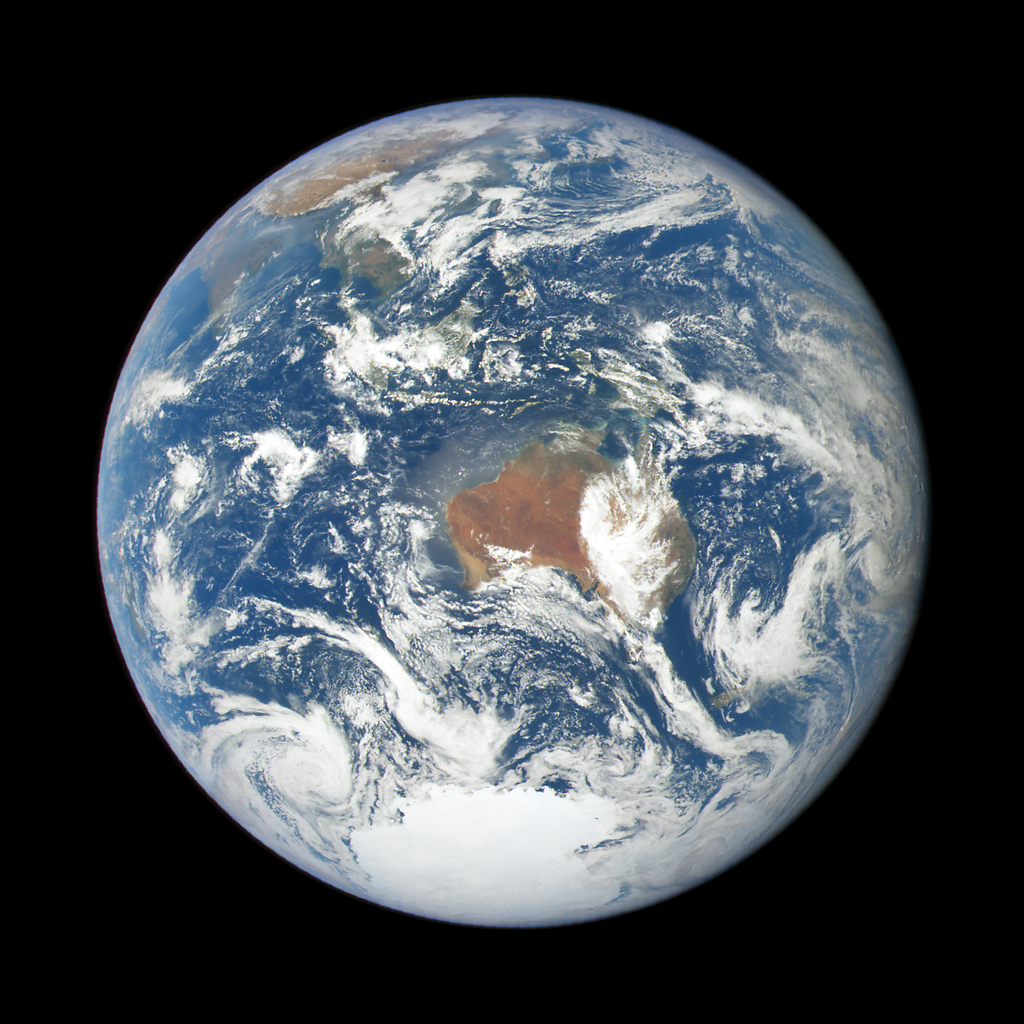The Earth hasn’t always been struggling with global warming. Around 34 million years ago at the Eocene-Oligocene Transition (EOT) the Earth was undergoing a period of global cooling. This significant shift in climate led to the formation of the first permanent ice sheets of the Cenozoic Era over Antarctica, as shown by the dramatic shift (in a geologic sense) in the oxygen isotope records [1]. The cooling, likely a result of declining atmospheric carbon dioxide levels but potentially also coinciding with Southern Ocean gateway changes, turned Antarctica from a green forested continent to the land of ice we know today. This is illustrated with an image of how this world might have looked.
Guest post by Alan Kennedy, University of Bristol
[I think this image is a great tool to communicate complex paleoclimate evidence – Ed]
The mock satellite image below, featured in a recent Science Perspectives piece, shows many of the key features that are known today about the EOT. The base map was adapted from those provided by Getech and vegetated according to simulations carried out using the fully coupled climate model HadCM3L and the dynamic vegetation model TRIFFID [2,3]. At elevated atmospheric CO2 levels relative to today, both Antarctica and Australia would have been covered with mixed forest during the Eocene, shown both by models and the fossil record [4].

As the Earth cooled and its orbit favoured cool Southern Hemisphere summers, ice would have started to accumulate over mountainous regions of the continent. The incipient ice caps shown here are taken from the seminal work of DeConto and Pollard on the EOT [5]. As the ice started to expand there would be a number of feedbacks with the atmosphere, including the height-mass balance feedback and an albedo feedback. These feedbacks would have stabilised the early ice sheet from melt and caused rapid growth once the ice caps reached a critical mass and altitude where they could start to expand across large plateaus of the continent.
The Tasman Seaway between Australia and Antarctica would have been narrow and shallow at the EOT [6]. There is evidence that it may have been highly biologically productive [7,8], which is shown in the image by the phytoplankton blooms off the continental margins and in the seaway. The role of this ocean gateway at the EOT is still largely unknown. Its impact on productivity and what affect this productivity might have on the carbon cycle on a geologic time scale for example, or its constraints on ocean circulation and how this might affect the physical climate response at the EOT provide a complex challenge for modellers.
Palaeoclimate research might not seem immediately accessible to a lay-audience. I constructed this map by merging modern day satellite images to help visualise some of the concepts discussed here. The outlines of the continents are hopefully quite easy to recognise and it is often only once the viewer has taken a moment to reflect on the image that they notice the colours and position seem ‘wrong’. I hope this will then encourage the viewer to think why the world appears different and engage with ideas of global change: that the world has always changed and will always continue to change, on a range of spatial and temporal scales.
Below is a modern day comparison satellite image from the DSCOVR satellite with a few more clouds:

I am a PhD researcher at the University of Bristol, a variety blogger and a highly infrequent tweeter.
1: Zachos, J.C., Shackleton, N.J., Revenaugh, J.S., Pälike, H. & Flower, B.P. (2001). Science, 292, pp. 686-693, doi: 10.1126/science.1059412
2: Lunt, D.J., Farnsworth, A., Lopston, C., Foster, G.L., Markwick, P.J., O’Brien, C.L., Pancost, R.D., Robinson, S.A. & Wrobel, N. (2015). Clim. Past Discuss. 11, 5683, doi: 10.5194/cpd-11-5683-2015
3: Kennedy, A. T., Farnsworth, A., Lunt, D. J., Lear, C. H. & Markwick, P. J. (2015). Philos. Trans. R. Soc. Lond. A 373, 20140419, doi: 10.1098/rsta.2014.0419
4: Thorn, V. C. & R. DeConto (2006). Palaeogeogr. Palaeoclimatol. Palaeoecol., 231, 134–157, doi: 10.1016/j.palaeo.2005.07.032
5: DeConto, R. M. & Pollard, D. (2003). Nature, 421, 245-249, doi: 10.1038/nature01290
6: Stickley, C.E., Brinkhuis, H., Schellenberg, S.A., Sluijs, A., Rohl, U., Fuller, M., Grauert, M., Huber, M., Warnaar, J. & Williams, G.L. (2004). Paleoceanography, 19, PA4027, doi: 10.1029/2004001022
7: Zachos, J.C., Quinn, R.M., & Salamy, K. (1996). Paleoceanography, 11, pp. 251-266, doi: 10.1029/96PA00571.
8: Diester-Haass, L. & Zahn, R. (2001). Palaeogeogr. Palaeoclimatol. Palaeoecol. 172, 153, doi: 10.1016/S0031-0182(01)00280-2
Does anyone really understand why the Earth was cooling or why cooling continued for the last 5 million years ? It don’t believe the primary cause can be anything to do with CO2 levels. CO2 acts merely as a feedback.
Hi Clive,
I understand what you mean in that CO2 does not change by itself, and so could be thought of as a feedback rather than the driver. The Science Perspectives piece actually discusses that quite nicely. I’ll try and summarise some ideas here:
It was suggested by Kennett back in 1977 that changes in Southern Ocean gateways (palaeogeographic changes) around the time of the EOT would have caused the thermal isolation of Antarctica and led to glaciation. This fell out of favour particularly following the work of DeConto & Pollard in 2003. This was due to a combination of uncertainty in the timing of the gateway changes, modelling studies showing a much clearer cooling response under CO2 vs palaeogeographic changes and the global nature of the temperature change recorded by proxies (i.e. the cooling was not limited to the Antarctic/Southern Ocean region).
However, as you rightly question, there has to be something causing the CO2 change. It is here that tectonics likely come into play. Changes in volcanism could have played a role. Additionally, changes in silicate weathering (which acts to draw down atmospheric CO2) due to the aridification and uplift of Asia and the Tibetan plateau around the EOT could also be important. Finally, as discussed in the Science Perspectives piece, changes in the Southern Ocean gateways could have had implications on ocean circulation, upwelling and deep water formation. This could have impacted ocean nutrient supplies, biological activity and hence carbon sequestration to the ocean.
The changes from any of these proposed mechanisms would have been relatively small, but on a geologic time scale could add up. Once CO2 reaches a critical threshold, other feedbacks associated with the ice expansion can then act to make the change appear rapid. While all of these mechanisms appear plausible, unpicking which process might be the most important is a very difficult task requiring an integration of carbon cycle, tectonic, ocean and climate models etc. In my opinion, to say we ‘really understand’ the cause of the cooling/CO2 decline would be very bold.
Clive,
As a former sound engineer for rock bands I dispute the use of the word “merely” in relation to feedback! Feedback can be very undesirable or very desirable depending on the wider context.
It was suggested by Kennett back in 1977 that changes in Southern Ocean gateways (palaeogeographic changes) around the time of the EOT would have caused the thermal isolation of Antarctica and led to glaciationaa
So few comments, I really hope more people care about this! Everyone should be learning all they can about our climate and why changes occur. I see so much warming where i live in Georgia, USA that its on my mind almost daily. I read every bit of info i can get my hands on. I hope that other people do the same.
https://en.wikipedia.org/wiki/Azolla_event
While this was several million years earlier than the EOT being discussed here, I am amused at the idea that humble pond weed could dramatically affect the planet’s climate – possibly an earlier stage leading to the events discussed in this article ?
“The event coincides precisely with a catastrophic decline in carbon dioxide levels, which fell from 3500 ppm in the early Eocene to 650 ppm during this event.”
I am not sure if my comment is relevant but when CO2 is converted by photosynthesis 4800 btus of solar energy per pound of CO2 are absorbed in the chemical reaction. This energy would otherwise become heat. The higher the initial CO2 the more is converted and the faster the cooling.
Hi Alan,
I met you this weekend at the green man and you made my day.
The conversation I had with you felt much more like a scientific one than a political one. Maybe this is because your area of expertise is not under the same scrutiny as others. I personally think its very important to find out how the crocodiles got up into the artic circle but Im not sure it is a crux point in emission quota debates.
So the spirt of scepticism , the ‘not sure’,’ we are feeling our way towards things but we can never be sure’ was at the heart of all the things you explained. This was always the way I expected science to work, Richard Dawkins explains the principle well and the philosophers I love (Hume in particular) gave us this great tool in the first place.
Although I understand the necessity of suspending scepticism to some amount, I disagree with it. It is such a fundamental principle. Often the climate debate is compared to Natural selection. Here we have a clear example of a theory that is so strong that there is consensus. I am glad there is, and find the creation science people to be the most obnoxious people I can imagine. But that is because natural selection is a simple clear modest idea that describes a mechanism. Everytime this mechanism is scrutinised it survives, new technologies like genetics add more supporting evidence. So through the endless survival of this idea, it builds in strength. It is now a very very strong theory, but still a theory.
Feynman uses the conversation of energy to make the same point. It may be that we need to throw things out from time to time, but somethings he wants to keep , they seem to work, and wherever you look they apply. The conservation of energy is one of these things.
So talking to you about your crocodiles that you cant model without burning down the forests reminds me of Feynman and the playful sceptical instinct of scientists.
Thankyou.
Dom